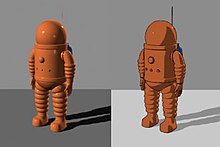Non-photorealistic rendering
Non-photorealistic rendering (NPR for short) describes a method for generating (“ rendering ” or image synthesis) computer graphics that deliberately do not correspond to the physically correct representation of a model.
overview
While the goal of most algorithms for rendering computer graphics is to produce a result that comes as close as possible to the model of a photo, this limitation is lifted with the NPR. With the help of current algorithms, starting from the same three-dimensional models, it is possible, for example, to generate images that look like line drawings, watercolors, oil paintings or the like. These types of algorithms, which do not depict geometrically correct shapes in a photo-realistic manner, are most frequently represented and (mostly) also possible as purely image-based variants (i.e. without considering the underlying geometry). However, there are other areas of the NPR such as B. non-photorealistic lighting or non-photorealistic projection: this breaks with optical laws and thus enables representations that are physically impossible in reality. Examples of this are inverse perspective (parallel lines diverge, objects become larger with increasing distance from the camera), several camera positions that are combined in one image, non-planar projection surfaces.
misunderstandings
Often, processes that are possible using traditional photographic approaches are also referred to as NPR. In some cases, these are processes in which, despite the possible application in photography, there is no mathematical image (a sharp projection onto a curved surface is quite possible within a certain framework, e.g. if a sufficiently small aperture is used when the image is enlarged is selected, but this does not correspond to a physical image), some are image-based falsifications which are not represented in the context of the "classic" photographic processes (examples of this are the bromine oil pressure and the Sabattier process), or else these are physically possible but apparently unknown to the users of computer technology, such as B. the image correction according to Scheimpflug . All these display methods, which can by all means be called "photo-realistic" according to the term, are sometimes referred to in the literature as NPR.
application
The NPR can be used in many ways: Line drawings are often easier to understand than photos in the area of technical instructions, and photos are an exception in medical textbooks. In other areas in which it was previously common to make drawings by hand, CAD programs are now used. In order to achieve the same results as before, NPR is often also necessary (an example is the drawing by architects, in which the level of detail in a line drawing reflects the status of the planning). NPR also plays a major role in the arts and computer games, see also Cel Shading .
literature
- Bruce Gooch, Amy Gooch: Non-Photorealistic Rendering. AK Peters, Natick 2001, ISBN 1-56881-133-0
- Thomas Strothotte , Stefan Schlechtweg: Non Photorealistic Computer Graphics: Modeling, Rendering and Animation. Morgan Kaufmann, San Francisco 2002, ISBN 1-55860-787-0
Web links
- Stylized Depiction in Computer Graphics - Overview with many links
